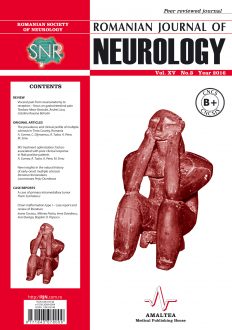SELECT ISSUE

Indexed

| |

|
|
|
| |
|
|
|

|
|
|
|
|
|
| |
|
|
HIGHLIGHTS
National Awards “Science and Research”
NEW! RJN has announced the annually National Award for "Science and Research" for the best scientific articles published throughout the year in the official journal.
Read the Recommendations for the Conduct, Reporting, Editing, and Publication of Scholarly work in Medical Journals.
The published medical research literature is a global public good. Medical journal editors have a social responsibility to promote global health by publishing, whenever possible, research that furthers health worldwide.
NEW INSIGHTS IN THE NATURAL HISTORY OF EARLY-ONSET MULTIPLE SCLEROSIS
Romana Homorodean and Lacramioara Perju-Dumbrava
ABSTRACT
Background. The early onset forms of Multiple Sclerosis (Paediatric MS, P-MS) have a low frequency, occurring in 2% to 10% of all MS cases. Age at diagnosis is a key feature for disease progression and prognosis in MS patients.
Objective. To evaluate the clinical features and course of MS in patients having the disease onset before the age of 18, according to age at diagnosis.
Methods. Patients with MS onset before age of 18 identified from Basse-Normandie MS regional registry, were included in the study. Patients were divided in two groups according to the age at MS diagnosis: the first group (group A) of patients in whom MS diagnosis was set before age of 18 and the second group (group B) including patients older than 18 years at MS diagnosis. Data related to clinical features and disease course were evaluated and compared between the two groups and also with some clinical data of adult MS patients included in the same regional database.
Results. A total of 41 patients with P-MS were included in the study, represented by 20 patients in group A and 21 patients in group B. Patients from group A had a more rapid progression to mild handicap (EDSS 3.0) than patients from group B (time to reach EDSS 3.0 of 6.34 vs 14.36 years; p=0.02) and they reached this level of disability at a younger age (21.17 vs 29.79 years; p=0.002). The duration of the first remission was significantly shorter in group A (1.44 vs 5.14 years; p<0.001) and the evolution to secondary-progressive (SP) form was faster when compared to group B (14.97 vs 27.57 years; p=0.01). Patients from group A had a greater risk to reach EDSS 3.0 or EDSS 6.0 as well as a greater probability to reach SP form (p<0.001) than patients from group B. Progression index (PI) of the entire paediatric group was significantly lower than mean PI in the adult group (0.29 vs 0.45; p=0.003) but not significantly different between the two groups (0.37 in group A vs 0.21 in group B).
Conclusion. P-MS forms show some clinical peculiarities, especially those with the age of diagnosis less than 18 years. They seem to have a more severe clinical MS course and a faster progression of disability.
Keywords: paediatric multiple sclerosis, epidemiology, course
Full text | PDF
